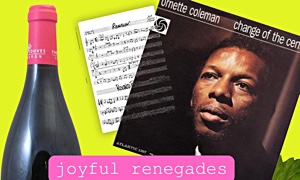Home » Jazz Articles » Jazz & Juice » Evolution: Chenin Blanc Meets Mary Lou Williams
Evolution: Chenin Blanc Meets Mary Lou Williams
Evolution
The word evolution seems to imply that there is an ultimate destination, some perfect state of arrival or completion towards which it builds. However, evolution is rather an ongoing process of change that never truly arrives at an endpoint. To our subjects: musical eras might have a moment of peak expression, yet music itself ever moves onward, feeding into the next expression of sound. Likewise, certain bottles of wine might be pinnacle moments for a winemaker's expression of nature, but time, change, and inspiration continue. Evolution is seldom linear—for an individual, it takes great faith to participate in one's own evolution, ever unsure of how or what the next phase of creation will manifest.In both jazz's history and that of wine, there are a few examples of those who have evolved through many milestone moments, shepherded in new inspiration, rode its wave, and then prepared for what came next. They are the artists who constantly evolve, and therefore, are fascinating. We'll spend time with one such artist this month, as well as a winemaker who is on her own path of evolution and progress. To evolve means to never stand still, and this legacy is true of the two women who created our music and wine of the month.
The Jazz
 Duke Ellington famously quipped that "Mary Lou Williams is perpetually contemporary." To be perpetually in and of the moment is the key to authentic evolution. Mary Lou Williams was ever in the moment, and her dizzying list of accomplishments, and her incalculable influence, speak to her own evolution and the transformations she inspired in others.
Duke Ellington famously quipped that "Mary Lou Williams is perpetually contemporary." To be perpetually in and of the moment is the key to authentic evolution. Mary Lou Williams was ever in the moment, and her dizzying list of accomplishments, and her incalculable influence, speak to her own evolution and the transformations she inspired in others. Rightfully referred to as jazz's queen, Williams was a creative, guiding force for the entirety of her lifelong career (which I couldn't possibly properly encapsulate here.) A few snapshots might suffice for our purpose: at 19 she was playing piano and arranging for the Andy Kirk Orchestra, and later arranged, played and composed for Louis Armstrong, Dizzy Gillespie, Benny Goodman (who was said to have pleaded to have her full-time, to no avail) and Duke Ellington (for whom she even served as a substitute with his orchestra.) After mastering myriad styles from blues to big band swing, she was a proponent of bebop as it emerged. Williams served as teacher to Charlie Parker, Thelonious Monk and other crucial figures in jazz history, while also ministering to many jazz musicians who suffered from addiction. She broke new ground in her later years writing the first liturgical pieces for the church in the jazz vernacular after her conversion to Catholicism in 1957, and left a legacy of playing through all the musical eras that most other musicians only lived through.
It's this last fruitful period of Mary Lou Williams' career where this month's selection derives, "Gloria" from Zoning, an album from 1974 released notably on her own label, Mary Records. The tune is a part of Mary Lou's Mass, released in 1975. Its jubilant and melodic music, underpinned by an irresistible groove, flows like a current through its many changes in and out of improvisation and inventions. The version I have chosen is instrumental to better showcase the beauty of the melodies and Williams' clear, multifaceted voice as improviser, but the original, sung in English, is also a joy to hear in its full ecclesiastical setting. True to her indefatigable and fearless exploration, her mass and this selection show more than musical mastery, a deep blues feeling, adventurous harmonic ideas, and an incredible arranger's ear—it's also unique in being a liturgy sung in English that embraces jazz language.
The entirety of Mary Lou's Mass was perhaps the first jazz, and certainly the first jazz mass, to be played in St. Patrick's Cathedral, and an emblem of the opening up of the Catholic service per the changes brought about in Vatican II. The messages of worship and hope for a unified world were born of a time when both church and state were struggling for solutions amidst great turmoil. Gloria is a timeless song of celebration and beauty created for a faith and a world badly in need of both a salve and a solution then, and now.
The Juice
 Our winemaker of this month's juice is also a formidable woman of legacy and forward thinking, whose work centers in the Loire Valley. Chenin blanc is one of those noble grapes (of which there are 18) which has somehow flown more or less under the radar. Perhaps it's because of the grape's versatility and adaptability that makes it tricky to pin down—it grows successfully in many corners of the world, and can have vastly different profiles and styles depending on where it's grown. In its home turf of the Loire Valley, styles that are dry (sec), semi-sweet (demi-sec), moelleux (sweet), and doux (really sweet) showcase the many ways Chenin exhibits its synthesis of lush, almost waxy texture, and vivacious acidity that can provide a backbone for all these styles, and for ageability in the cellar.
Our winemaker of this month's juice is also a formidable woman of legacy and forward thinking, whose work centers in the Loire Valley. Chenin blanc is one of those noble grapes (of which there are 18) which has somehow flown more or less under the radar. Perhaps it's because of the grape's versatility and adaptability that makes it tricky to pin down—it grows successfully in many corners of the world, and can have vastly different profiles and styles depending on where it's grown. In its home turf of the Loire Valley, styles that are dry (sec), semi-sweet (demi-sec), moelleux (sweet), and doux (really sweet) showcase the many ways Chenin exhibits its synthesis of lush, almost waxy texture, and vivacious acidity that can provide a backbone for all these styles, and for ageability in the cellar. Our example this month is Domaine du Clos's La Jalousie 2018 from Savenniéres; a fantastic wine that also shows what evolutions are happening in the region and specifically with this winemaker. The winemaker in question, Evelyne de Jessey-Pontbriand, is an innovator who carries on one of the most historic properties in the region. Her fusion of contemporary adaptation (she has introduced biodynamic techniques to the vineyard, organic certification, and other detailed advances in management) with respect to the rich line through history and lineage of this property, make her poised between past and future, atop the crest of evolution's wave.
The history that informs the wine is rich. This wine, as well as many others, owes much of its persistence through history to Catholic orders of monks (in this case, Cistercians), who perpetuated vineyard cultivation until the bourgeois were permitted to do so. Also notable is that Evelyne de Jessey-Pontbriand is the third woman to inherit this estate along the maternal line—her mother having served as president of the appellation before her.
Evolution builds on what came before not just by preservation but development. This particular wine, the most plentiful and available of the Closel line, is distinctive in that the grapes are picked earlier than most in the region, which can often have an intensity brought about by ripeness and noble rot (botrytis) which both infects and concentrates the grapes. In this bottle, a core of fresh acid takes the fruit and flavors of the wine on a rollercoaster ride on the palate, journeying the weight and flavors of the wine with length and panache.
What's Next
There's much to discuss here—the maternal lines that created this wine and music, the influence of the church on their preservation and perpetuation, and the ways the legacies of each inform the present moment. I'll see you in next week's video and end of the month podcast. As always, comments are very welcome, as are your emails to me here!Tags
PREVIOUS / NEXT
Support All About Jazz
 All About Jazz has been a pillar of jazz since 1995, championing it as an art form and, more importantly, supporting the musicians who make it. Our enduring commitment has made "AAJ" one of the most culturally important websites of its kind, read by hundreds of thousands of fans, musicians and industry figures every month.
All About Jazz has been a pillar of jazz since 1995, championing it as an art form and, more importantly, supporting the musicians who make it. Our enduring commitment has made "AAJ" one of the most culturally important websites of its kind, read by hundreds of thousands of fans, musicians and industry figures every month.





















